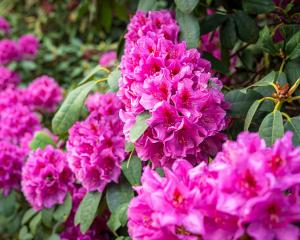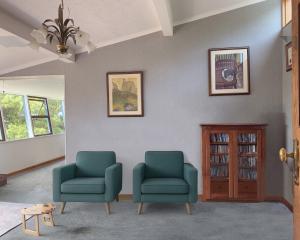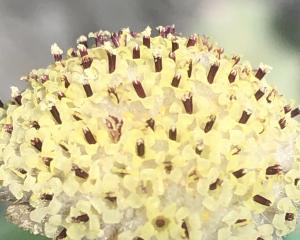This year, Dunedin Botanic Garden is celebrating its 150th anniversary. Gillian Vine talks to a former gardener who began work in the garden 65 years ago.
We talked about crops in those days and the first two I looked after in the glasshouse were hippeastrums and streptocarpus.
I had to ask the foreman what they were called and when he told me, I thought 'Good Lord, are all the names going to be like this?'- Cliff Donaldson IT was a hard winter in 1948.
Cliff Donaldson remembers helping his father, who owned a Dunedin nursery, to chip away 5cm to 8cm of solidly frosted ground before they were able to dig roses for customers.
For the 15-year-old Cliff, leaving for an apprenticeship at Dunedin Botanic Garden may have felt like light relief.
Working hours were 8am to 5pm Monday to Friday, but staff were rostered on to do weekend work, especially in summer when watering was crucial.
For Saturdays, a day in lieu was given, and for Sundays, they were paid double.
His basic wages were just 1.11s.11d a week and by the time he had paid his board and other expenses, including a three shilling bus ticket, he had about seven shillings a week left, ''so it was hard to save'', Mr Donaldson (80) recalls.
''I was put to work looking after this old run-down glasshouse with panes of glass missing.''
Heating was done with coal or coke-fired boilers and he remembers having to scrape out the clinker, a dirty job.
''We talked about crops in those days and the first two I looked after in the glasshouse were hippeastrums and streptocarpus.
"I had to ask the foreman what they were called and when he told me, I thought `Good Lord, are all the names going to be like this?'
''The glasshouse-raised plants were destined for the ''marvellous displays'' that were a major attraction in the Lower Garden where indoor displays were changed three times a year.
"The 10 glasshouses in the propagating area included others devoted to orchids, begonias and cyclamen, as well as a hot bed for growing cuttings.
''You can imagine the jokes about it when we put the dahlia Bishop of Llandaff in with a plant with a lady's name,'' Mr Donaldson says.
Bedding plants were grown outside under glass, then hardened off by gradually lifting the glass covers so they could get used to cooler temperatures before they went into their permanent homes.
''It was quite a business,'' he says.
Chrysanthemums were popular with the public and he has a photo of a fine display of ball-headed beauties.
They were very labour intensive, as they were grown from cuttings and the entire process to reach flowering stage took a year.
One of his more interesting - and dangerous - jobs was working on the redevelopment of the rock garden.
In 1904, when David Tannock was superintendent, the area above Lindsay Creek had been developed to grow alpines. That was extended in 1911 and then, beginning in 1950, major redevelopment took place.
''Monster boulders from Mt Cargill were dropped up above the rock garden and the only way we could get them into position was with a cable attached to a winch or a timber box.''
If a boulder was in the wrong place, moving it was done by the staff using crowbars.
''Moving one, I got clobbered on my eyebrow with a piece of four by two,'' Mr Donaldson says.
Overseeing the work was an English alpine expert.
''They brought this fellow Alf Wootten out from England and he was an expert in propagating alpine plants.
''He lived at the Robbie Burns [hotel] . . . and he was a great one at playing the piano for free drinks. Then he would retire upstairs with one of the local harlots. He was always grumpy in the mornings, not surprising.
''I don't know whether he outlived his welcome or they ran out of funds [but the work] was left only about a quarter or a third done.''
When developing the rock garden was resumed in the 1980s, Mr Donaldson ''couldn't get over the way they did it, using a front end loader to lower the rocks''.
After the rock garden, he was transferred to the New Zealand collection.
''I was quite pleased about that, as I had always liked natives.''
He added pittosporums, some of them quite rare, to the collection but - by now several years out of his apprenticeship - found it extremely frustrating to have to ask the superintendent, Maurice Skipworth, for permission to make even the smallest change and to spend most of his time on maintenance.
''At the time, they were short of postmen in Dunedin, so I became a postie, getting slightly more pay than I had as a journeyman gardener.''
Like many postmen at the time, Mr Donaldson had a second job, growing hedging plants for his brother, who had taken over the family nursery. He kept up his interest in natives, too, gathering them from the bush, then growing and propagating them at his Leith Valley property.
He has also maintained a keen interest in the Dunedin Botanic Garden and is a long-standing member of the Friends of the Botanic Garden.
Although he accepts change, he regrets the reduction in floral displays, feels too much emphasis now is placed on trees and would like to see some of the large, old ones thinned.
''And I've been on at them [garden staff] to have a fernery again'' he says.












